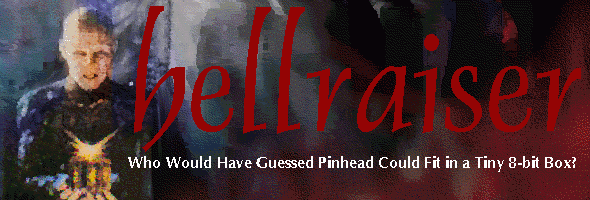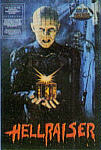

Greetings again from the hazy past. This issue I would like to call your attention to Color Dreams. Chances are if you were an NES junkie during 90-91 you probably heard of this company. It got its notoriety from publishing non-licensed NES games. All in all they sold 25 titles for the 8-bit, but none of those are my focus. Some of you may recall seeing old Color Dreams ads, and may even remember seeing them advertise a game called Hellraiser. One ad showed a box cover--Pinhead holding a cube--and another actually showed a screen-shot from the game. More than anything, many gamers have wondered what happened to this game so often shrouded in heaps of rumor. Well, in a recent call to Color Dreams, I spoke with a Dan Lawton who has been with the company from the start, and got some interesting answers regarding what made this cart tick, and why it would have been such a big deal had it been released.
 Box shot of the Hellraiser game.
Box shot of the Hellraiser game.
Rumors at the time said that the game had some sort of special version of a MMC chip in it that actually contained an extra 8-bit processor. Dubbed by gamers the "Super C" chip, it would supposedly let your 8-bit Nintendo display graphics like a 16-bit machine. Other more fabulous rumors even suggested that the cartridge used the bottom row of pins to access an unused duplicate 8-bit processor on the NES motherboard. This rumored processor was assumed to have something to do with the "mystery port" on the bottom of the deck.
Unbelievably, the actual history is not far from the rumor. The game Hellraiser was engineered during the year 1990. The cartridge had a Z-80 processor in it running at 2 MIPS (Million Instructions Per Second). This gave the game 3 times the computational power of the NES console alone. The cartridge also had 64k of RAM (Random Access Memory) on-board. This means that the game could store 64 thousand characters of information independent of the NES console.
In Hellraiser, the game fully bitmapped out the screen to memory first (the processor on the game could draw with more colors, and handle more sprites at one time than the NES), and though Mr. Lawton could not recall off hand how many colors or sprites exactly were available, he assured me it was a significant amount more.
All in all from the description I got, this game sounded like it would have kicked butt. I would have enjoyed seeing Color Dreams release a title this cool. Ah well...
Mr. Lawton explained to me that it was the potential price that dictated the life of this game. It would have cost in the range of $80 for someone to buy, and because most stores refused to carry Color Dream's games for fear of retaliation from the Big "N", consumers would have had a difficult time buying the game--thereby causing potentially small sales. In the end it all came down to the issue of money as it does with many things in life, and the title was scrapped to a box to gather dust. At this point Mr. Lawton doesn't believe there is even a working copy in existence.
But all hope is not lost for those of you dying to see this game. Word is there will be a version for the PC available in January that uses the graphics driver from Wolfenstein 3-D, and is based on the original 8-bit game. From the sounds of it, it will be packed with violence, gore and hopefully lots of gross stuff. Otherwise what would be the point of the game?
Looking ahead, there may also be a Japanese SNES release through a different company sometime next year (although the violence will be scaled down to be sure). Hopefully we will be able to bring you reviews of both of these versions when they become available.
That about wraps it up for this issue. So until next time, I think I'll be passing my time digging through some old 5200 games. (Yeah this has nothing to do with the article, but I just got an urge to play The Dreadnaught Factor!) Later...
Originally appeared Vol 2, Iss 4 (11-12/93)